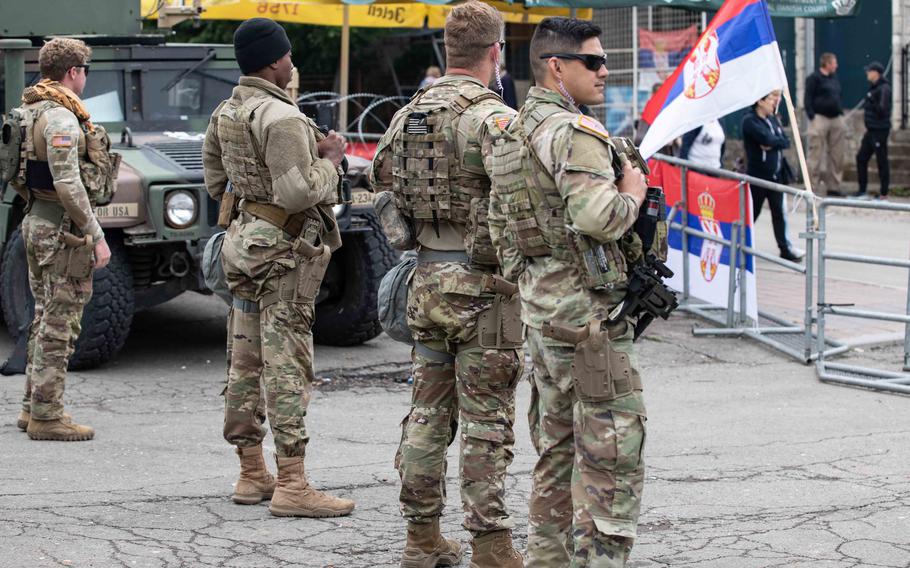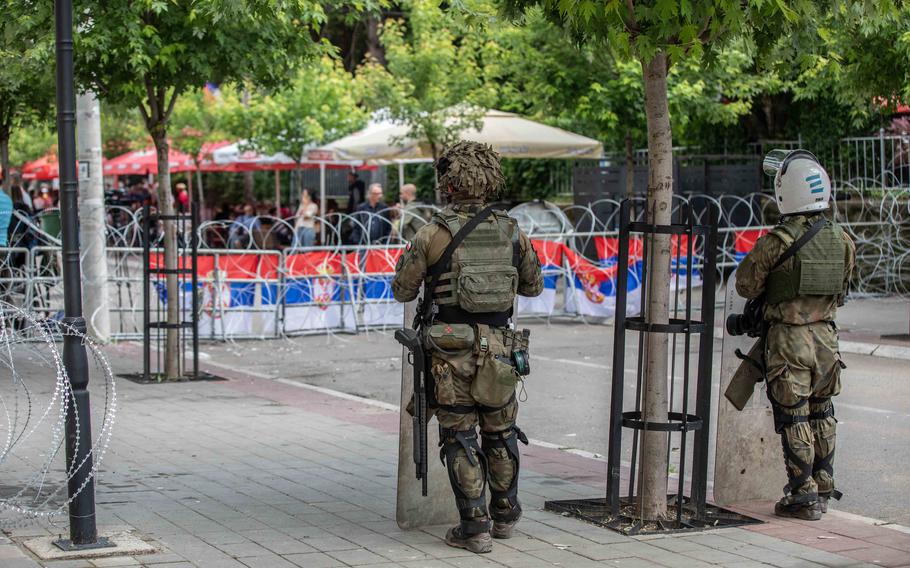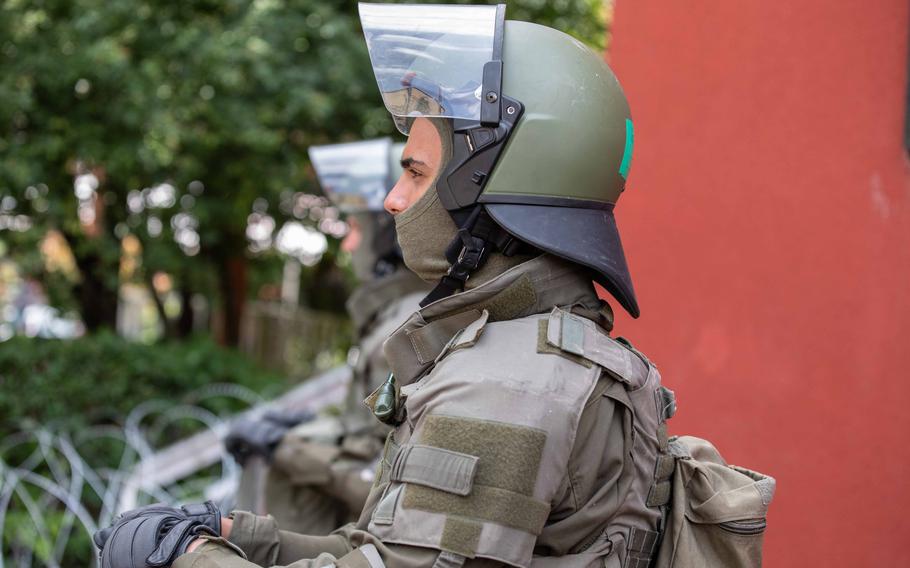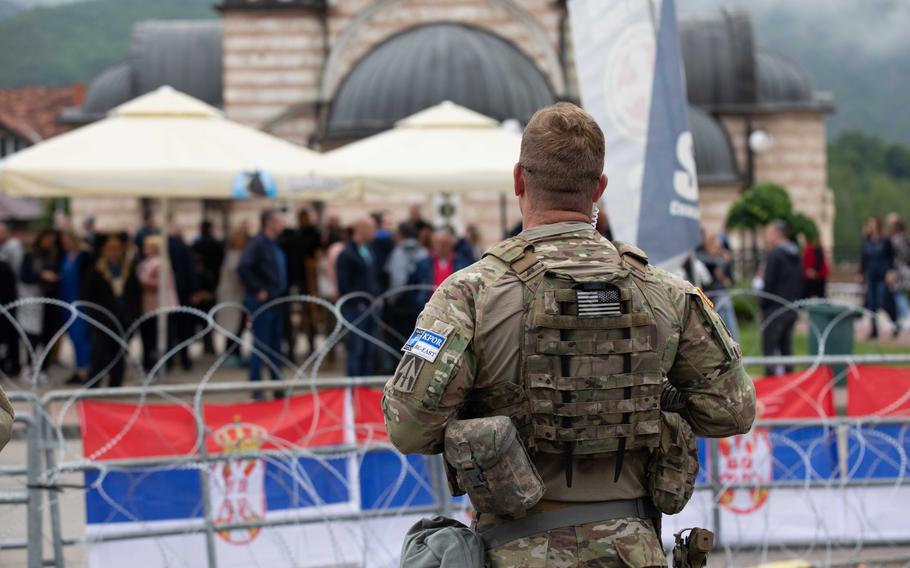
Kosovo Force Regional Command-East soldiers stationed at Camp Nothing Hill respond June 2, 2023, to the civil unrest and protests in Leposavic, Kosovo, that began May 26. (Anna Pongo/U.S. Army)
The American commander of a Kosovo Force contingent said the situation in his sector was calm but fragile Monday, a week after his soldiers were attacked by Serbs angry about the outcome of local elections.
Col. Chris Mabis, leader of the Indiana National Guard’s 76th Infantry Brigade Command Team and head of Regional Command-East in Kosovo, blamed a small group of agitators for the violence, which resulted in injuries to about 30 soldiers.
He and a small group of U.S. forces were in the town of Zvecan on May 29 when the most serious outburst happened, he said.
No Americans were injured, but three KFOR soldiers were shot, and others were injured by grenade fragments, clubs and pipes. The wounded soldiers were evacuated by U.S. military aircraft.
KFOR, once made up of multiple sectors that included thousands of troops from NATO and other countries across Europe, is based out of Pristina, with forces responsible for eastern and western segments.
The U.S., which formerly led forces in the southeast of the country, has essentially taken over command of both the former British and French sectors in the center and north.

Polish soldiers with Kosovo Force Regional Command-East respond to the civil unrest and protests June 1, 2023, in Zvecan, Kosovo. The U.S. commander blamed agitators for violence that broke out during the demonstrations. (Anna Pongo/U.S. Army)
Italians in the west of the country are also in charge of the southwestern sector, originally Germany’s responsibility.
Mabis said the situation could have been much worse because KFOR forces were authorized to use deadly force if necessary.
“I made the decision to not use that force due to the fact there would have been innocent civilian casualties,” he said Monday. “I have no doubt about that.”
Mabis said soldiers were guarding municipal buildings and the people inside after it became clear that some Serbs wanted to remove the recently elected Albanian mayor from them by force.
Serbs largely boycotted the voting in late April resulting in a very low turnout and victories by ethnic Albanian mayoral candidates in four municipalities: Zvecan, Leposavic, North Mitrovica and Zubin Potok.
Mabis, whose sector normally includes a U.S. infantry battalion and companies from Turkey, Latvia and Poland, asked for more troops. In response, Italians from RC-West and Hungarians from the KFOR reserve took up positions in Zvecan.
About 750 people gathered, calling for the mayor to vacate the building, Mabis said, adding that the majority of them were peacefully protesting. But a crowd encircled a group of Kosovo police officers and started to vandalize their cars.

Austrian soldiers with Kosovo Force Regional Command-East respond June 1, 2023, to unrest in Zvecan, Kosovo, where violence caused injuries to soldiers and demonstrators. (Anna Pongo/U.S. Army)
After about eight hours trying to negotiate their release, Mabis said, it became clear the situation was going to deteriorate. So he ordered troops to advance to clear space.
“There were a group of agitators that very clearly attacked KFOR soldiers,” he said.
Troops later found shell casings. Besides guns, the attackers used flash-bang grenades, fragmentation grenades, clubs or pipes.
The troops tried to protect themselves with shields and batons. Mabis said some protesters also were injured.
“I can’t say enough good things about how the soldiers responded, regardless of nationality,” he said.
Four protesters were detained and turned over to Kosovo police.
Mabis said he agreed to talk about the episode to counter false narratives that have spread through social media.
“There’s a lot of misinformation out there,” he said.
The U.S. will implement a new rotation in June, with troops from the Texas National Guard getting set to train in Germany before heading to Kosovo.
“There is a tremendous amount of pressure from the international community on the institutions of Kosovo to deescalate and pressure on the Serbian side to do the same,” Mabis said. “My assessment is there will be a peaceful resolution.”

Kosovo Force Regional Command-East soldiers stationed at Camp Nothing Hill watch protests in Leposavici, Kosovo, that began on May 26, 2023. (Anna Pongo/U.S. Army)